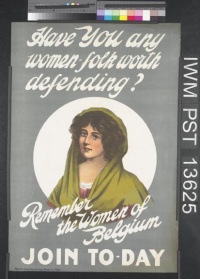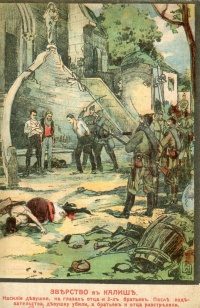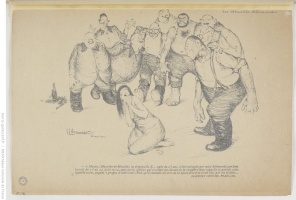Introduction↑
At the end of the 19th century, rape, commonly seen as an unfortunate but inevitable consequence of armed conflict, was not counted as one of the acts prohibited by the laws of war. Rape was only indirectly mentioned by the Hague Conventions of 1899 and 1907 that required occupying armies to respect "family honor and rights, the lives of persons, and private property" (Article 46). Still, the various commissions the belligerent parties set up during the First World War to investigate their enemies’ crimes, all made a point of stressing the number of rapes committed in the territories invaded. These inquiry reports, often published immediately in order to discredit the other side, are the main source for historical research on this subject. Since this documentation asserted, as in the case of the French commission set up in September 1914, that: “attacks on women and girls were of unprecedented violence”,[1] and recorded acts that were mostly carried out during the early months of the war, it gave credence to the idea that a threshold of sexual violence was crossed during the First World War, particularly during periods of invasion. However, while the rape of the other side’s women appears to have been neither an isolated nor an exceptional phenomenon, there is no evidence that it occurred on a massive or systematic scale. The frequent tendency in the literature to treat rape as a type of violence mainly connected with the specific period of invasion is due to an availability bias that is corrected to some extent by research into documents other than those produced by the commissions of inquiry. This additional documentation reveals information about rapes committed during occupation and military withdrawal.
World War I↑
When, in August 1914, the German army entered Belgium and France, its soldiers committed a large number of rapes along with other assaults on civilians. The actual number, impossible to estimate in the current state of research, was without a doubt considerably higher than the small number that was officially recorded. This is because many victims were too ashamed to report that they had been raped, and because press coverage and official discourse implied a lower number of rapes than were actually occurring. Inquiry reports into German atrocities, newspaper articles, drawings, engravings and novels gave unprecedented visibility to this wartime violence against women. The topic of German rape became a focus of representations of warfare and the enemy until the end of the war. This became a key lever in anti-German propaganda, extensively used in, for example, the Bryce Report, published in the British press in spring 1915. This report was translated into several languages and widely circulated.
In newspapers and government propaganda, the rape of women was presented as a symbol of the cowardly, criminal aggression the motherland had suffered, and it was used as a powerful tool for mobilising men to fight a just war of civilisation against barbarity. Public opinion was particularly shocked by collective rapes committed in public along with other physical violence including murder. The perpetrators appeared to be driven by a desire to humiliate female victims first, over whose bodies they asserted their domination, representing an extension of their control of territory. The humiliation of men was secondary and represented their inability to defend the women who were being put on public display. However, most of the aggressive acts appear to have been committed by single soldiers or groups of two or three, using the threat of a weapon and preferring to act with no witnesses present.
The most well researched and documented incidents of rape occurred in France and Belgium in 1914-1915, but invaders committed rape in other places and times during the war. On the Eastern Front, Russia and the Central Powers accused each other of offences against the civilian population. Cases of rape were reported by German refugees from East Prussia after the Russian invasion in 1914. In Galicia and Bukovina, the Jewish population was particularly targeted by the brutality of the Cossacks, whose pillage, destruction, murder and rape were condemned in Austro-Hungarian reports. German violence was also reported in Poland, when the Tsar had to relinquish after the Central Powers’ offensive in summer 1915. However, civilians were treated much worse by the scorched-earth policy of the retreating Russian troops than by the German invaders. The documentary evidence is greater and better researched for rapes by German and Austro-Hungarian troops in Friuli and Veneto in 1917-1918 after the Italian defeat at Caporetto. These rapes were committed in a similar fashion to those in France and Belgium at the start of the war.
Most historians agree that the rapes committed by soldiers in the First World War were neither planned nor encouraged by commanding officers but merely tolerated as the undesirable but inevitable effect of a temporary slackening of military discipline. The Serbian case, however, appears to be an exception to this general pattern. Recent studies have shown that the Bulgarian occupation of southern Serbia from 1915 to 1918 gave rise to ethnic violence, including mass rapes encouraged by officers, with the aim of eliminating the Serbian and Greek populations of Macedonia. Unlike the German atrocities, these systematic aggressions committed in Serbia aroused very little reaction abroad and were not referred to in Allied propaganda.
In France, and to a lesser extent Italy, the revelation of German rapes gave rise to a controversy around the children to be born as a result. In early 1915, some sections of public opinion, believing that the “enemy’s children”, by their Germanic extraction, might represent a mortal danger of degeneracy for the “French race”, pressed for their abortion, and even excused infanticide. The publicity these ideas received in a press vying to compete for patriotism and feed its readers’ fantasies, should not be taken at face value: the supporters of eradicating German genes were only a tiny minority among politicians and senior medical figures, and the government quickly put an end to the matter by reasserting the illegality of abortion and organising the care of these children by the Assistance Publique (AP) in Paris.
From 1915 to 1921, 361 children born of German rape were taken in by the assisted children service of the Seine département and registered under the ad hoc category of “Special decisions”. From this figure it has been estimated that a total number of between 1,000 and 5,000 children were born to French women raped by German soldiers during the First World War. The personal files of these children taken in by the AP in Paris, 80 percent of whom were born following aggressions committed after the first quarter of 1915, show that historiographers have too often seen rape as a violence connected with the German invasion, and have underestimated the extent of sexual aggression committed after the frontline had stabilised.
The occupation period saw rape where the perpetrator, usually acting alone, knew his victim, at least by sight, and did not always abscond after his crime. The requisition of military billets and female labour in fields and factories created situations particularly likely to lead to aggression, which often occurred after a period of days or months of non-violent acquaintance. To subdue their victims, the soldier rapists used blows and the threat of a weapon, but the violence could also be more emotional than physical, and would increase over time in some instances. Some women described the hunger that they and their children were forced to endure by soldiers who, before the women gave in, would offer them food for sex; in other cases, the climate of fear and a sense of powerlessness among the residents of the occupied territories was enough for a soldier to obtain a victim’s submission.
Although these occupation-period rapes are beginning to be better understood, other aspects of the subject remain understudied. Research into the Eastern Front is largely lacking. Similarly, little work has been done on the aggressions committed by the winning side, for example, after the autumn of 1918, the rape of German women was increasingly alluded to in the correspondence of French soldiers who were about to occupy the Rhineland. Despite a few cases recorded by historians, particularly of sexual aggression by British soldiers in France, rape within populations not at war is also a subject that is poorly researched.
Conclusion↑
Whereas rape by the enemy loomed large in the minds of the peoples involved in the war and was a recurring theme in some national propaganda, no mention was made of it in post-war commemorations and discussions. Although explicitly added to the number of war crimes at the Peace Conference that opened in Paris in January 1919, rape quickly disappeared from the talks. It was not until 1949, following the Second World War, when sexual violence had occurred on a far greater scale than in the First World War, that rape was specifically prohibited by the laws of war.
Antoine Rivière, Université Paris 8
Section Editor: Emmanuelle Cronier
Notes
- ↑ Rapports et procès-verbaux d'enquête de la commission instituée en vue de constater les actes commis par l'ennemi en violation du droit des gens (décret du 23 septembre 1914), t. 1, Paris 1915, p. 8.
Selected Bibliography
- Audoin-Rouzeau, Stéphane: L'enfant de l'ennemi 1914-1918. Viol, avortement, infanticide pendant la Grande Guerre, Paris 1995: Aubier.
- Bianchi, Bruna: Crimini di guerra e contro l'umanità. Le violenze ai civili sul fronte orientale (1914-1919), Milan 2012: UNICOPLI.
- Harris, Ruth: The 'child of the barbarian'. Rape, race and nationalism in France during the First World War, in: Past & Present 141, 1993, pp. 170-206.
- Horne, John / Kramer, Alan: German atrocities 1914. A history of denial, New Haven 2001: Yale University Press.
- Rivière, Antoine: 'Special decisions'. Children born as the result of German rape and handed over to public assistance during the Great War (1914-18), in: Branche, Raphaëlle / Virgili, Fabrice (eds.): Rape in wartime, Basingstoke 2012: Palgrave Macmillan, pp. 184-200.













